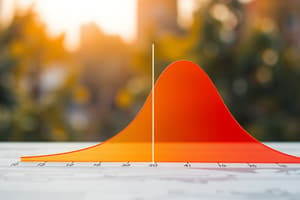Podcast
Questions and Answers
मुख्य आपूर्ति में परिवर्तन किसके कारण हो सकता है?
मुख्य आपूर्ति में परिवर्तन किसके कारण हो सकता है?
- कारक मूल्यों में परिवर्तनों के कारण (correct)
- क्रोधि प्रगति के कारण
- ब्याज दरों में परिवर्तन के कारण
- कर्मचारी में संशोधन के कारण
व्यापारिक चक्र किसे कहा जाता है?
व्यापारिक चक्र किसे कहा जाता है?
- उचित मूल्य के संप्रेषण
- कारक मूल्यों में परिवर्तन
- संसाधन आवंटन में परिवर्तन की
- वृद्धि और संकुचन के अवधि (correct)
बेरोजगारी क्या दर्शाती है?
बेरोजगारी क्या दर्शाती है?
- सक्रिय रूप से काम ढूंढने वाले लोगों की संख्या (correct)
- संकुचन (मंदी) के समय सक्रियता
- लोगों की निषेधाजनक आत्मा
- सकारात्मक प्रतिक्रिया की संभावना
मुद्रा संरचना किसके पर्यावेक्षण में है?
मुद्रा संरचना किसके पर्यावेक्षण में है?
राष्ट्रीय आमदनी में किसे शामिल किया जाता है?
राष्ट्रीय आमदनी में किसे शामिल किया जाता है?
मैक्रोइकोनॉमिक्स क्या अध्ययन करता है?
मैक्रोइकोनॉमिक्स क्या अध्ययन करता है?
मैक्रोइकोनॉमिक्स के अंतर्गत किन-किन परिकल्पनाओं की जांच की जाती है?
मैक्रोइकोनॉमिक्स के अंतर्गत किन-किन परिकल्पनाओं की जांच की जाती है?
मैक्रोइकोनॉमिक्स में कौन-सा महत्वपूर्ण सिद्धांत Aggregate Demand परिभाषित है?
मैक्रोइकोनॉमिक्स में कौन-सा महत्वपूर्ण सिद्धांत Aggregate Demand परिभाषित है?
मैक्रोइकोनॉमिक्स का मुख्य उदेश्य क्या है?
मैक्रोइकोनॉमिक्स का मुख्य उदेश्य क्या है?
मैक्रोइकोनॉमिक्स के अंतर्गत कुछ महत्वपूर्ण सिद्धांतों में से कि हमें Employment Fluctuations में सहायता पहुंचती है?
मैक्रोइकोनॉमिक्स के अंतर्गत कुछ महत्वपूर्ण सिद्धांतों में से कि हमें Employment Fluctuations में सहायता पहुंचती है?
Flashcards are hidden until you start studying
Study Notes
Understanding Macroeconomics
Macroeconomics isn't just about balancing your bank account; it's a vast field of study focused on understanding entire economies instead of individual markets. As we delve into this fascinating subject, let's explore its foundations, key concepts, and real-world applications.
Defining Macroeconomics
Macroeconomics examines large-scale economic patterns — trends and behaviors occurring across whole nations, regions, and sectors. This includes aggregates such as national income, unemployment rates, GDP growth, inflation levels, interest rates, exchange rates, fiscal policy, monetary policy, international trade, and global finance. By studying these broad factors, macroeconomists attempt to explain why particular economies perform well while others face struggles. They also develop strategies to improve overall economic performance by proposing policies designed to stimulate growth and stabilize price levels.
Important Concepts and Models
To make sense of complex matters like economic cycles, employment fluctuations, and investment decisions, some fundamental models have been developed over time. Here is a sample of pivotal concepts and theories often explored within macroeconomic discourse.
-
Aggregate Demand: Refers to total spending made by households, businesses, government, and foreign buyers in an economy during a specific period. It helps us understand how shifts in demand affect production and prices.
-
Aggregate Supply: Represents all goods and services produced in an economy given current resources and technology levels. Changes in aggregate supply can result from adjustments in resource allocation due to changes in factor prices or technological progress.
-
Business Cycles: Refer to periods of expansion (boom) and contraction (recession), creating movement within our economy's productivity. Business cycles help identify when interventionist measures might be needed to reinvigorate lagging industries and dampen overheated ones.
-
Unemployment: A measure reflecting the number of individuals actively seeking work without success. High levels indicate both personal hardship and potential future challenges for the broader economy in achieving sustained growth.
-
Inflation: Indicates average change in general prices for consumer goods and services over time. Persistent high levels undermine purchasing power and exacerbate inequality, whereas low levels may render savings less valuable.
-
Interest Rates: Determined by banks and influence borrowing costs affecting consumption, saving behavior, investment expenditure, and even business startups. Interest rates fall under the purview of monetary policy.
-
National Income: Comprised of all final income earned domestically, including wages, rentals, profits, interests, dividends, royalties, and other sources of revenue.
Real-World Applications
Within this framework, several core areas of application emerge:
-
Fiscal Policy refers to actions undertaken by governments to manage public spending and taxation aimed at influencing the level and composition of output in an economy. Examples include cutting taxes or increasing government expenditures to boost economic activity during recessions.
-
Monetary Policy concerns central banks regulating the money supply through instruments such as setting interest rates or altering reserve requirements. These interventions target controlling inflation, promoting economic stability, and fostering sustainable economic development.
The intricate world of economics provides endless opportunity to learn more about the forces shaping society, politics, and culture today. So, whether you aspire to become a professional economist, better comprehend the daily news cycle, or merely seek to augment your overall understanding of the modern world, mastering macroeconomics could prove exceptionally rewarding!
Studying That Suits You
Use AI to generate personalized quizzes and flashcards to suit your learning preferences.




